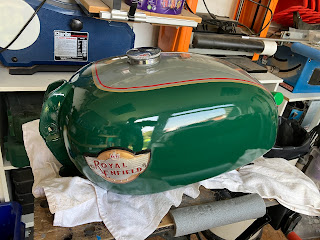Now that the initial shakedown runs are done, I'm treating that as the end of the restoration and the start of the fettling and riding stage!
My future adventures on her will be recorded on my Noel's Adventures blog.
I have loved this restoration and I'm so proud of taking her from a rusting pile of bits that had lain unloved at the back of a garage for 40 years to an attractive and capable machine, albeit one that is 62 years old! I can't wait to get out on some camping/touring adventures with her and explore what she is really capable of. I've already got a trip across to the Isle of Man booked for a few days during Manx GP practice week.
My thoughts on the aim of the restoration from two years ago were:
"So my thoughts for the Crusader have been that I wanted to end up with a presentable old bike that I could happily roll up to a classic show on and display, safe in the knowledge it would never win a prize for best in show, but also that I won't be afraid to sling some camping gear on the back of and head off to the Classic TT or on a weekend camping trip.
I am not aiming for 100% originality. Anyone coming to me at a show and saying" I think you'll find that the 1962 Crusader used a Lucas xyt7 lens and not the earlier xyj4" will probably get a polite shove off.
I would like to reuse or repair rather than renew, although not where the economics of doing that are ridiculous. The bike is probably never going to be worth more than about £3000 maximum and I have spent just under £1000 on the purchase - £2000 isn't a lot once you start a project like this!"
I reckon that I have pretty much achieved that objective. Another driver was that I had remembered my dad telling me that a Royal Enfield Constellation & sidecar was his last bike he had in the 50s, which seemed like a nice link as he died a couple of years ago. Well, this one's for you Dad x
You may wonder how much this all cost? I stopped counting the cost quite a while ago, but reckon it's probably around £3,000, including the initial purchase price. I did make a conscious decision at some point that I wasn't going to buy cheap parts and, particularly in the engine, most came from Hitchcock's to try and ensure a certain level of quality. A couple of parts (e.g. levers and throttle controls) came from autojumbles and I've probably been less happy with those. If I was doing it again I'd probably stand a couple of hundred pounds extra cost for better parts all round.
Maybe if I keep her for a few years she'll appreciate in value a bit and I'll have covered my costs, but this has never been about making money. I have thoroughly enjoyed the whole process, and the feeling of bringing her back to life has been priceless.
So I'll leave it here with some before and after photos to summarise.




















































